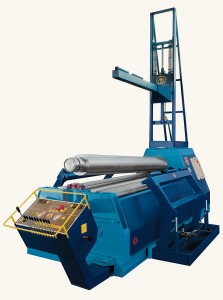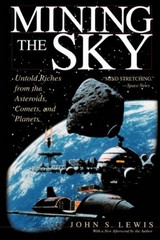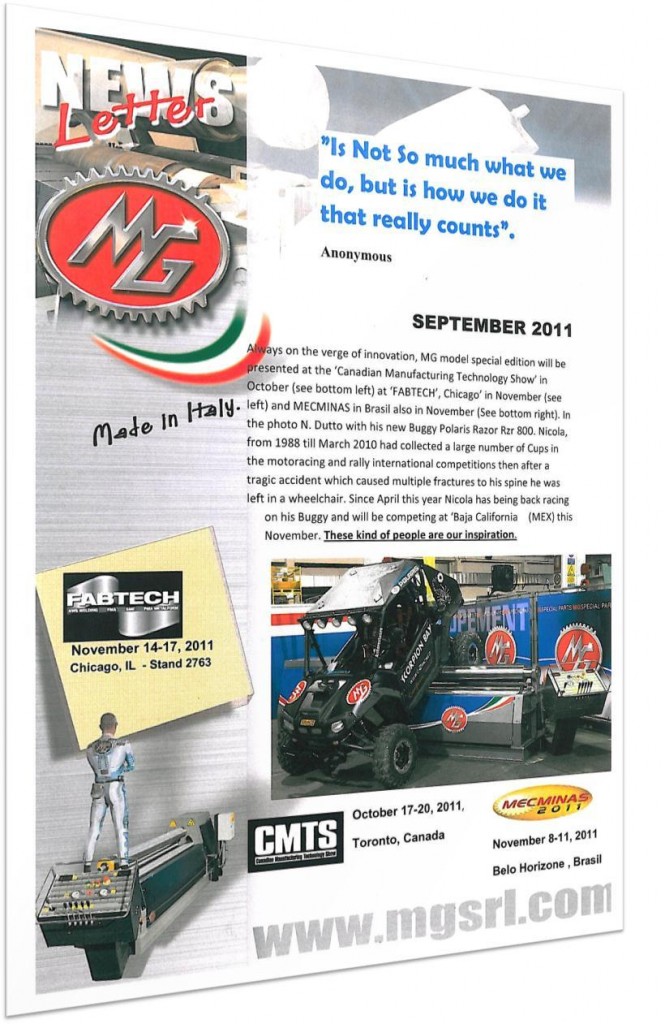Year: 2011
Video on MH208A 4 rolls Plate Bending Machine
MH208A with central and one arm side supports bending square tank with CNC Touch Command “EVO”
And below video on bending eliptic tank with CNC Touch Command “EVO”
Factory test on MG370Y – 3-roll Machine
Plate Bending Machine 3 rolls 10′ X 2-3/4″/2.2″
Video on AR80 Section Bending Machine – Angle bending
Come Meet Us at Fabtech 2011 Booth # 2763
We are very excited about exhibiting at Fabtech 2011 in Chicago, November 14-17, 2011 and hope that you will stop by at our booth #2763 to learn more about us and our products.
Come talk to our knowledgeable and friendly sales personnel. Ask questions. Pick up brochures. Get ideas.
This year we have a MH 4-roll plate bending machine on the floor. Come and take a look.
All our plate rolls are built in Fossano, Italy, by MG s.r.l. MG gives customers real advantages on every large and small industrial application of boilers and heat exchangers; tanks and containers for food industry, agriculture and buildings; tank-trucks for oils and foods, road and heavy transportation; turbines and reactors; off-shore and land windmill towers; light and heavy steel structural works, excavator buckets and any other application in the field of automotive, naval, railway and aero-spatial. Every one of these sectors is carefully studied by our staff in order to give our clients the best machine, system or service.
Our machines are built to follow each customer’s specific bending requirements, expressly studied and projected for the task the customer needs to perform. We do not mass-produce and we don’t send out quotations just to get rid of stock. We want to know what the customer’s activity is, what he produces, and listen to what he would like to have in the future and then offer the best machine that can fit his demands.
In addition to showing you the plate roll we would like to inform you about the rest of our extensive product line from brakes, shears and rebar equipment to laser cutting and plasma burning machines.
 Double Pinch Hydraulic 4 Roll Plate Bending Machine Model MH314C. Click below for information on the roll.
Double Pinch Hydraulic 4 Roll Plate Bending Machine Model MH314C. Click below for information on the roll.
Click HERE for information on the MH314C
Back to Basics: The Sledgehammer

When it comes to the bare-knuckle basics of metal-working machinery, nothing says “old school” quite like the sledgehammer. This is “grassroots” machinery at its finest. Although they were and still are commonly used by blacksmiths to shape heavy sections of iron, the uses for a sledgehammer are practically unlimited. With this in mind, it only makes sense that in addition to her nail file and wallet, every woman should keep a sledgehammer in her purse at all times.
First of all, the name alone conjures up near-mythical images of wanton, gratuitous destruction. This is a good thing. Sometimes, all you have to do is casually mention the word, and people around you might feel more inclined to “do the right thing” when it comes to whatever that may be. So in that sense, the mere mention of the word “sledgehammer” might be enough to inspire your associates to work a little more quickly and efficiently. I’m probably preaching to the choir here since this is Management 101, but it does bear mentioning since this fundamental technique is so essential to good, effective leadership.
Secondly, it is a truly practical tool, and certainly its uses are not limited solely to ridiculously crude forms of metalworking. If you have a sudden need to bash something, a sledgehammer can be your best friend. Although acoustically there are few sounds more satisfying than sledgehammer-on-metal, it can also be used to bash a variety of objects or solids, from glass to concrete. I have personally witnessed an excellent instance of Man vs. Television, which took place in a neighbor’s front yard years ago, in which the sledgehammer being wielded by the Man was the deciding factor in winning that round. And yes, it was one of those neighborhoods that Bravo will never select for a season of Real Housewives.
Finally, the therapeutic benefits of using a sledgehammer cannot be ignored. If you aren’t willing or able to spend a day at a full-service spa (for either financial reasons or because you males are worried about getting your Man-cards revoked if you do), then consider the sledgehammer as an excellent alternative for your stress-relief needs. Not only is work with a sledgehammer excellent exercise, you will also find yourself extremely relaxed (if not completely passed out on the floor) by the time you have finished your sledgehammer workout. According to Wikipedia, “sledgehammers usually require two hands and a swinging motion involving the entire torso”, which makes it a comparable physical activity to Pilates. A note of caution, however: it pays to be slightly choosy about what object or surface you plan on sledgehammering. As effective as it is, it is difficult to rebuild something after it has been subjected to a sledgehammer workout session.
If you run out of ideas for your sledgehammer, you do what I did and Google “uses for sledgehammer”. You’ll be amazed. From driving fenceposts into the ground, to using them for both burglaries and for police-force raids to gain entry by force, the list of possibilities for a sledgehammer is nearly endless. With that said, my all-time personal favorite use for a sledgehammer can be found at WikiAnswers.com. The question being asked was, ““How do you take apart an upright piano?” One reader answered with the following gem (the typos aren’t mine):
“There are many ways if u dont want to be able to reassemble it afterwards take a hammer or better yet a sledgehammer or if u want it to be able to reassemble try using a screwdriver on the screws.
If u really want to take it apart to small pieces use some explosives.
Having had experience with a sledgehammer and an upright piano, I hope you are strong and in good physical condition – it will take all day. My husband suggests a catapult a la “Northern Exposure” and I tend to agree.”
If I could choose my own neighbors, I’d pick the couple that mentions sledgehammers and catapults as viable solutions for taking apart a piano.( read how to select best digital piano 2017 online) I really respect the fact that the wife’s recommendations for using a sledgehammer on a piano are actually backed by her own experience in the matter. I imagine that going over to their house for a beer would be highly entertaining. I’d just make sure to stay on their good side, and to not pick a home not located anywhere near the projectile path of their catapult.
-Anja Wulf
Video on MG 32520Z test-rolling 10′ plate
This is the biggest plate bending machine in the world.
- Weight: almost 400 tons / 800,000 lbs
- Machine capacity: 250 mm / 10″, able to bend plate 250 mm / 10″ thick on total length of 3,200 mm / 126″.
- Top roll diameter: 1,400 mm / 55″
- Side rolls diameter: 1,200 mm / 47″
- Total length of machine: 13,700 mm / 45′
- Height: 7,700 mm / 25.3′
- Width: 7,100 mm / 23.3′
- Weight of top roll: 53 tons / 116,600 lbs
- Side rolls (2): 47 tons each / 103,400 lbs
- 17 trucks needed for the transport from Italy to Spain
MG September 2011 Newsletter
Come visit us at Fabtech 2011 in Chicago, IL November 14-17, 2011, booth # 2763!!
Now Hiring: Asteroid Miners
 A long, long time ago, in a galaxy we are all familiar with, asteroids rained all the gold, cobalt, iron, manganese, nickel,osmium, molybdenum, palladium, rhenuim, rhodium, ruthenium and tungsten that we will ever mine from this planet, onto the earth’s crust.
A long, long time ago, in a galaxy we are all familiar with, asteroids rained all the gold, cobalt, iron, manganese, nickel,osmium, molybdenum, palladium, rhenuim, rhodium, ruthenium and tungsten that we will ever mine from this planet, onto the earth’s crust.
Based on known earthly reserves and growing rates of consumption in developing countries, it has been speculated that metal reserves essential for modern industry, including antimony, zinc, tin, silver, indium, gold and copper, could be depleted from Earth within the next 50-60 years.
For the above two reasons alone, I am willing to bet that international space exploration is about to take off. Why? Because at the rate we’re going, in a few years, you will no longer be able to look down for metals: you’ll have to look up. Space exploration is going to expand fiercely and rapidly because there is going to be an exceedingly practical reason for it that is far more interesting to most of us than pure science: namely, competition, and huge amounts of potential profits. Soon, we will be going to go back to the source for metal resources – and that will take us into outer space, into a fantastically interesting subject known as asteroid mining.
Near-earth asteroids are considered the most immediate likely candidates for asteroid mining. At 1997 prices, a small metallic asteroid no wider than 1 mile across was calculated to contain more than $20 trillion worth industrial and precious metals– so at today’s prices, it would be even significantly more than that. As another point of comparison, a 1 km-wide asteroid would probably contain more than 2 billion metric tons of iron-nickel ore, which would be more than twice the global annual production of iron ore in 2004. That doesn’t even include whatever precious metals it would also contain.
Apparently, there are three different ways of mining asteroids:
1. Bringing back raw material from the asteroid for processing on earth;
2. Processing the asteroidal materials on-site, thus reducing transportation costs and possibly even producing fuel propellant from the raw materials for the trip home; or (my favorite):
3. Dragging the entire asteroid to a safe orbit around the moon or Earth, so that the majority of its materials can be used and not wasted. It looks like pretty much all you need to know about asteroid retrieval methods, or “catching”, can be found in this handy Wikipedia link: Methods for asteroid retrieval or catching . Although probably a tad on the expensive side, it could be a far more interesting weekend hobby than fishing. At the very least, it brings new meaning to the idea of a pet rock.
What is interesting to note is that, although it is conceded that the cost of asteroid retrieval still outweighs their market value and that at current commodity prices and space transportation costs it is not expected to attract private investment, it doesn’t say anywhere that the technology needed to do this doesn’t exist. In other words, it can be done. And even if you or I can’t afford it right at this moment, it will be done. If you decide to get serious about this, it seems that all you need to know about the subject is available on Wikipedia. And remember, when the headlines about asteroid retrieval start circulating more regularly, you can say you heard about it right here, on the C Marshall Fabrication Machinery website blog, first.
-Anja Wulf
Two Rolls Bending Machines with Robotic Arm Uploader
2 x two rolls bending machine with robotic arm in the center that upload alternatively.

